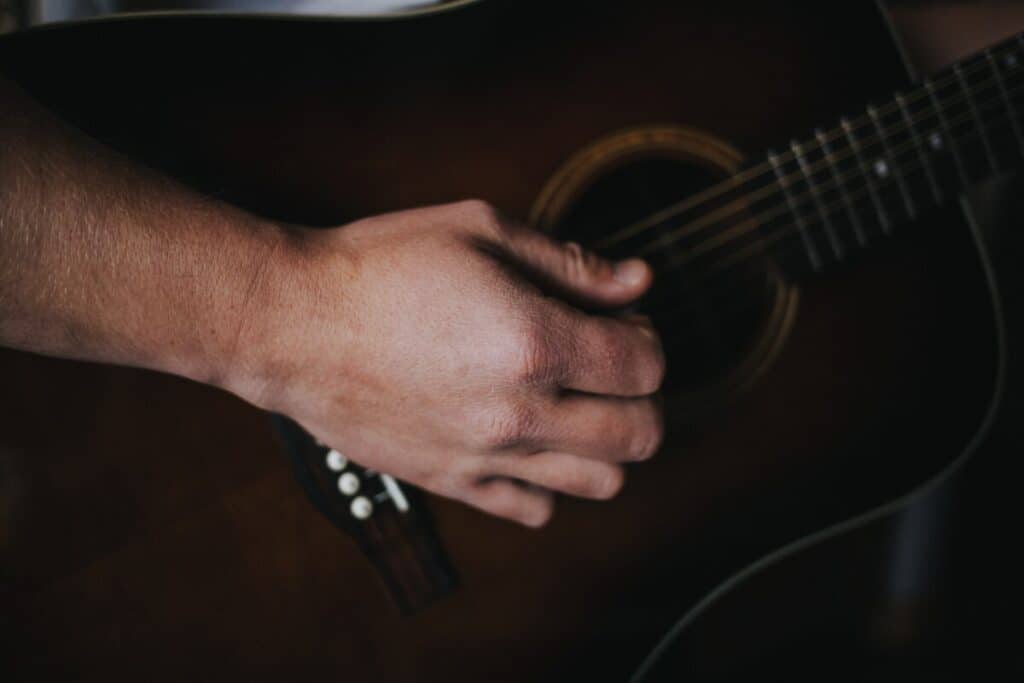
With so many brands, gauges, and varieties of acoustic guitar strings out there, it can be hard to choose the best guitar strings specifically for fingerpicking. Lucky for you guys, I’ve tried a lot of them, and am here to give you the inside scoop on the very best fingerpicking guitar strings.
My number one choice for acoustic fingerpicking strings is Elixir’s Nanoweb guitar strings. These strings are coated with Elixir’s famous Nanoweb technology. This means there is a thin polymer coating around the surface of the guitar strings, which gives them a smooth feel but more importantly allows them to last much longer.

This means you get the same great tone, but from strings with a much longer lifespan. Many guitarists find their elixir strings can last 1-2 months or even longer depending on how much you play. Fingerpicking, especially if you use your nails, can wear down your strings quite quickly. That’s why I prefer to use coated strings, and milk the most tone out of them that I can for as long as possible.
Uncoated Acoustic Strings for Fingerpicking
Elixirs are by far my favorite fingerpicking strings, but what if you’re looking for an uncoated acoustic guitar string? In that case, I would go with D’Addario EJ11 acoustic strings. These uncoated guitar strings strike an ideal balance of tone and playability, and still last a good amount of time for uncoated strings.

There are a few reasons some fingerpickers opt for uncoated guitar strings. Some guitarists prefer the feel and sound of uncoated strings, finding them a little more vibrant than coated strings.
Uncoated strings typically don’t last nearly as long as coated ones, but some players are okay with having to change their strings more often if it means they can really nail the tone that they are looking for.
Some guitarists also choose uncoated strings because:
- They are less expensive
- They have more of a “grip” when fretting, while coated strings are smoother
- They may provide a slightly more traditional tone
I totally understand opting for uncoated acoustic guitar strings, and still use them myself from time to time. If you prefer uncoated strings for your fingerpicking needs, then you can’t go wrong with the D’Addario EJ11.
The Best String Gauge for Fingerpicking / Fingerstyle
Now that we have a good idea of the best two brands for fingerpicking, as well as a coated and uncoated options, let’s discuss the best string gauge for fingerpicking on your acoustic guitar.
Fingerpicking and fingerstyle guitar are more easily performed on a lighter gauge set of strings. This is because the heavier a string is, the more energy it will take to pluck it and make it ring out. If you are fingerpicking with the flesh of your fingers especially, it may be wise to opt for a lighter gauge set of acoustic guitar strings.
If you use a thumb pick or pick with your nails, you could perhaps tolerate a heavier gauge of acoustic guitar strings. Heavier string gauges, while a bit more difficult to play, produce a richer tone with more volume and sustain. If you are ready for the challenge, medium gauge strings strike a nice balance between playability and rich tone.
Overall, I would recommend sticking between light and medium gauge acoustic strings for fingerpicking or fingerstyle guitar playing.
Still Can’t Decide? Here’s What to Do
Now you know the best acoustic guitar strings for fingerpicking! But I know it can be tough to pull the trigger when making decisions like these, so I’ll break things down as simply as possible.
If you want to pick up some coated acoustic strings, go with the Elixir Nanoweb acoustic guitar strings. These will provide great feel, tone, and playability while also lasting incredibly long between required string changes.
If you instead prefer uncoated, grab the D’Addario EJ11 acoustic strings. While these won’t last as love, they’re very inexpensive and offer a great classic tone. If you’re relatively new to the world of acoustic guitar, it probably makes the most sense to grab both and see what you prefer! It’ll be a valuable investment and learning opportunity. And trust me – you won’t be disappointed with either brand of strings.
When it comes to guitar string gauges, stick with light if you’re just starting out. Afterwards, you can work your way up to medium over time and see if the tone difference is worth the extra effort from your fretting hand. If you’re intermediate or more experienced, you can opt for medium gauge strings. Again though, my best recommendation would be to try both gauges and see what you prefer.
I hope that was helpful, and that you now have the tools necessary to enjoy your fingerpicking and fingerstyle guitar playing.
If you’d like to pick up some Elixir nanowebs, you can do so here.
Or grab D’Addario’s EJ11 acoustic strings.
Thanks for reading, and as always, happy picking!
